Whether lighting an art gallery, museum, an art studio or your living room, selecting the best lights for a work of art requires knowledge and understanding of footcandle requirements, beam spread, color temperature and color rendering.
Table of contents
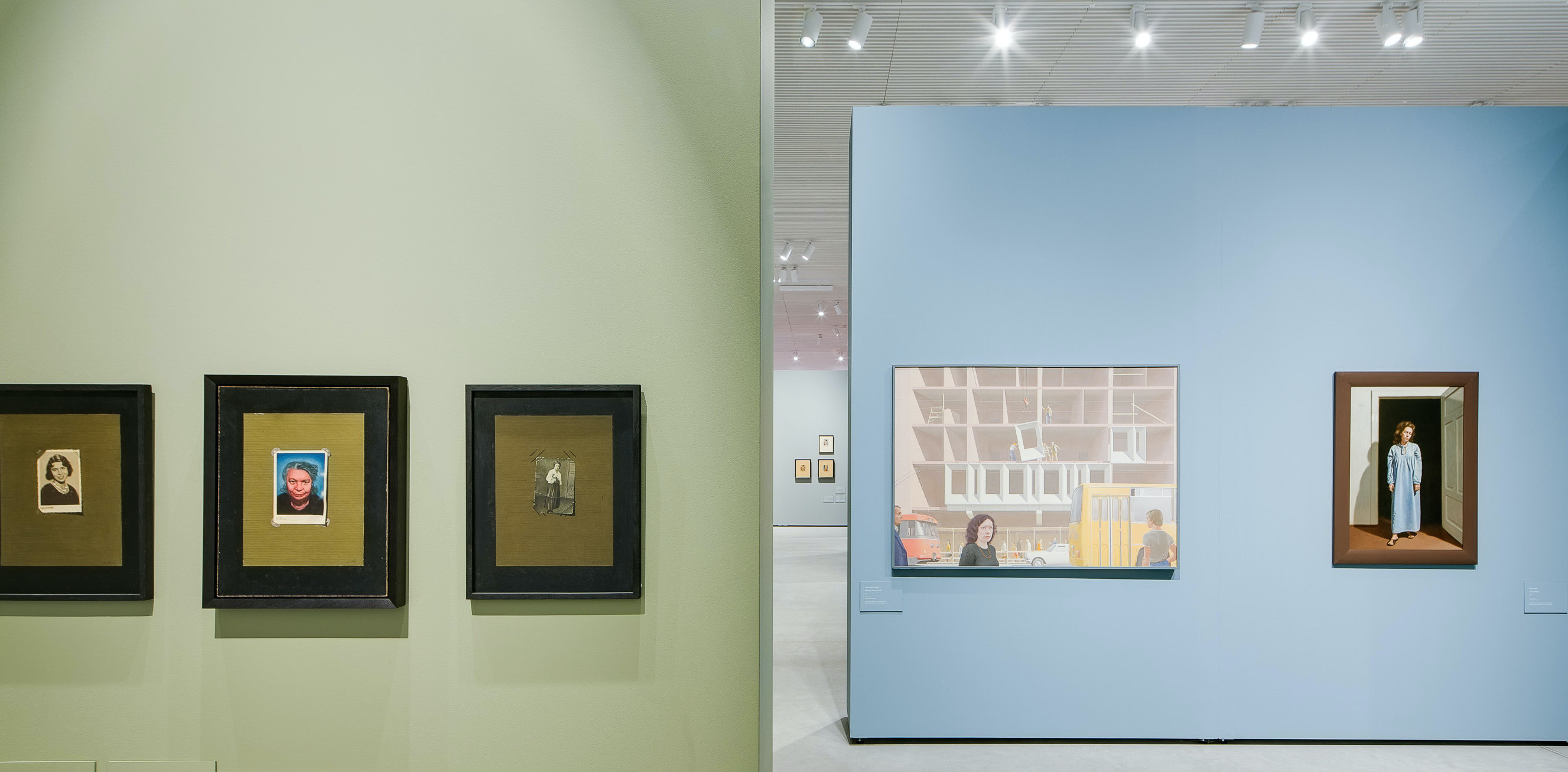
Why is lighting important in galleries?
Lighting is an essential feature in art galleries, as it can enhance the art viewing experience and bring artworks to life. Without proper lighting, art pieces can appear dull, muted or distorted. Thus, art galleries need to select the correct lighting setup for each individual artwork to accurately represent the artist’s vision.
Additionally, lighting also has a major impact on the ambiance of a space and can set the mood for an art gallery exhibit or presentation. Art galleries and museums (not to mention your own home!) can use specific lighting solutions that will create an inviting atmosphere while bringing out all the details in the artwork on display. Ultimately, good art lighting is key in conveying both emotion and detail.
Key aims of lighting art
The four primary aims of lighting artwork are as follows: visibility, color rendering, focus and preservation. Achieving a balance between these aims is crucial to creating an optimal viewing environment for artwork.
1. Visibility
Lighting should ensure that the artwork is clearly visible to viewers. Proper illumination helps to reveal details, colors and textures, allowing viewers to appreciate the nuances of the piece.
2. Accurate color rendering
Lighting should reproduce colors accurately to maintain the integrity of the artwork. Proper color rendering ensures that viewers see that artwork as intended by the artist, without distortions or shifts in color perception.
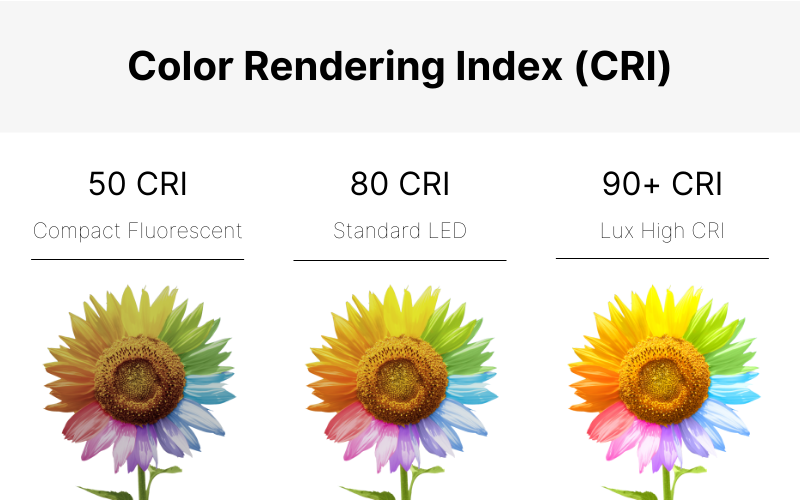
3. Highlighting focal points
Lighting can be used strategically to emphasize specific areas or elements within the artwork. This helps guide the viewer’s attention to key focal points, enhancing the overall visual experience.
4. Preservation
Light can cause damage to artworks over time, particularly sensitive materials like pigments and paper. Proper lighting aims to minimize the potential for damage by controlling factors such as intensity, duration and UV radiation, thus contributing to the preservation of artwork.
What light do artists use?
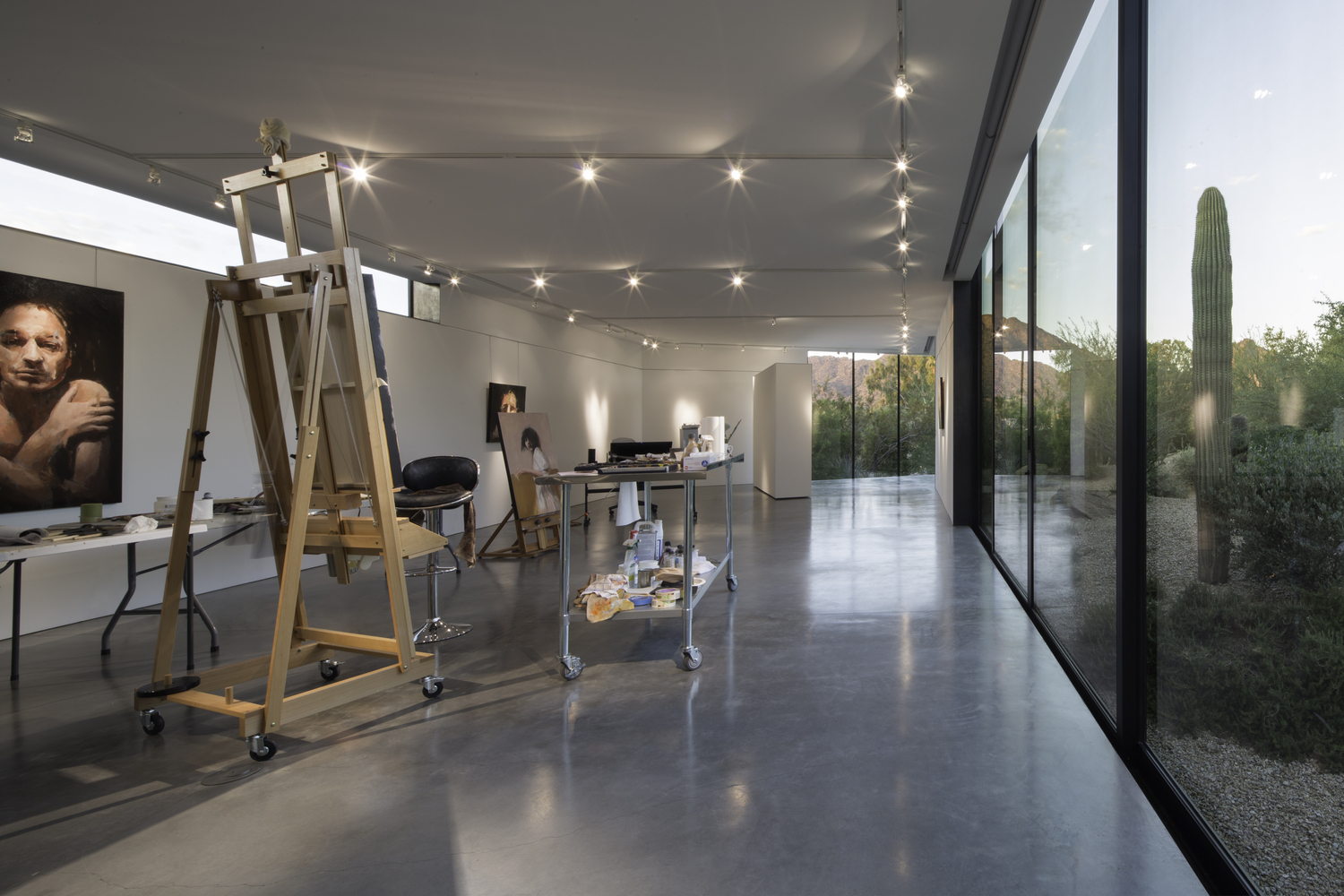
In addition to natural sunlight artists often use task lighting, such as desk lamps or clamp lights, to illuminate specific areas where detailed work is being done because it provides focused, consistent, and concentrated illumination. Task lighting can be anything from incandescent bulbs, adjustable LED lights, daylight bulbs, fluorescent lamps and halogen bulbs. This wide range of options means that color rendering is often different than what the artist might have used while designing. For this reason, when accurate information can’t be found through research, the best route is to choose a color option that best highlights the individual piece or a group of pieces being displayed together.
5 tips for the best lighting in an art gallery
Creating the besting lighting in an art gallery is essential to enhance the visual impact of the artworks and provide a positive viewing experience. Remember to tailor the lighting design to the specific needs of the artworks and the gallery space. Regular maintenance and monitoring of the lighting system is also crucial to ensure consistent and optimal conditions for exhibiting art. Here are five tips for achieving optimal lighting in an art gallery:
1. Use adjustable lighting fixtures
Install adjustable lighting fixtures that allow you to control the direction, angle, and intensity of the light. This flexibility enables you to highlight specific artworks, control glare and adapt to different types of art.
2. Balance natural and artificial lighting
Integrate natural light when possible, but control it to prevent direct sunlight from causing damage to artwork. Supplement natural light with artificial lighting to maintain consistent illumination throughout the space, especially during evening hours and cloudy days.
3. Consider color temperature
Choose lighting with a color temperature that complements the artwork. Warm color temperatures (e.g 2700K) can enhance traditional art, while cooler temperatures (e.g 4000K) may be suitable for contemporary pieces. Consistency in color temperature across fixtures ensures uniformity in the gallery space.
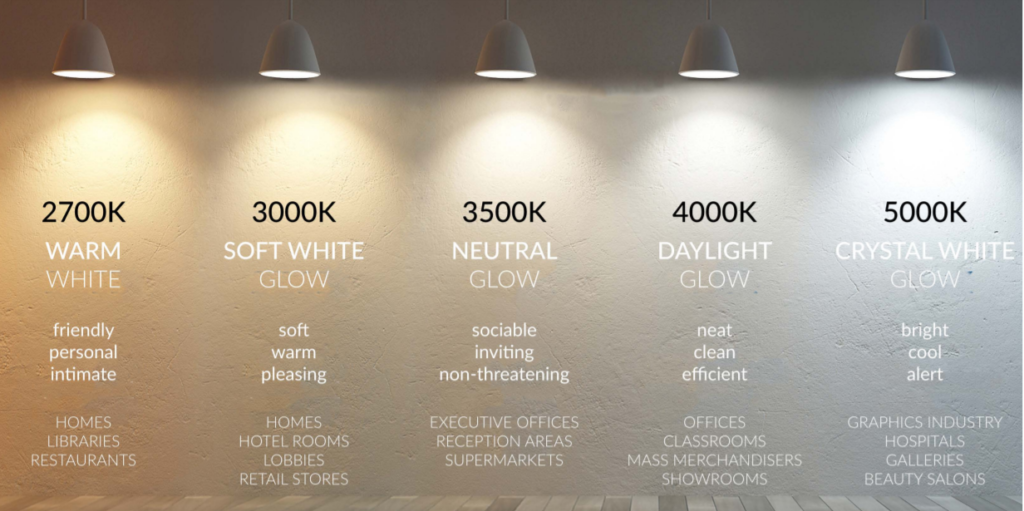
Natural lighting is considered by many to be the best light for displaying fine art because sunlight has the highest CRI (Color Rendering Index), which is the measurement of a light source’s capacity to accurately reveal the various colors of an object. In other words, it’s the truest representation of the actual colors in a work of art.
Color-tunable lighting is a lighting technology that allows users to adjust the color temperature and intensity of light. It combines LEDs of different color temperatures into single bulbs or strips.
Color tuning is ideal for installations where the owner of the space wants flexibility and control over lighting. The ability to alter both the hue and brightness of lighting enables art displays to be tailored for a particular piece or artist, creating more depth and impact for viewers. The result is an enhanced viewing experience: Patrons see the work as the artist intended.
4. Minimize UV exposure
UV exposure can lead to fading and deterioration of pigments and materials. Protect pieces by reducing UV radiation in the gallery. Use lighting fixtures with UV filters or select bulbs that emit minimal ultraviolet (UV) radiation. Install UV filtering glass in frames or UV filtering film on windows.
5. Create layered lighting
Implement a layered lighting approach to achieve depth and dimension in the gallery space. Combine ambient lighting for overall illumination with accent lighting to highlight specific artworks or areas. This creates a dynamic visual environment and emphasizes the gallery’s architecture.
Directional lights, such as track lighting and adjustable recessed lighting, offer the most flexibility for aiming the light at the desired art piece.
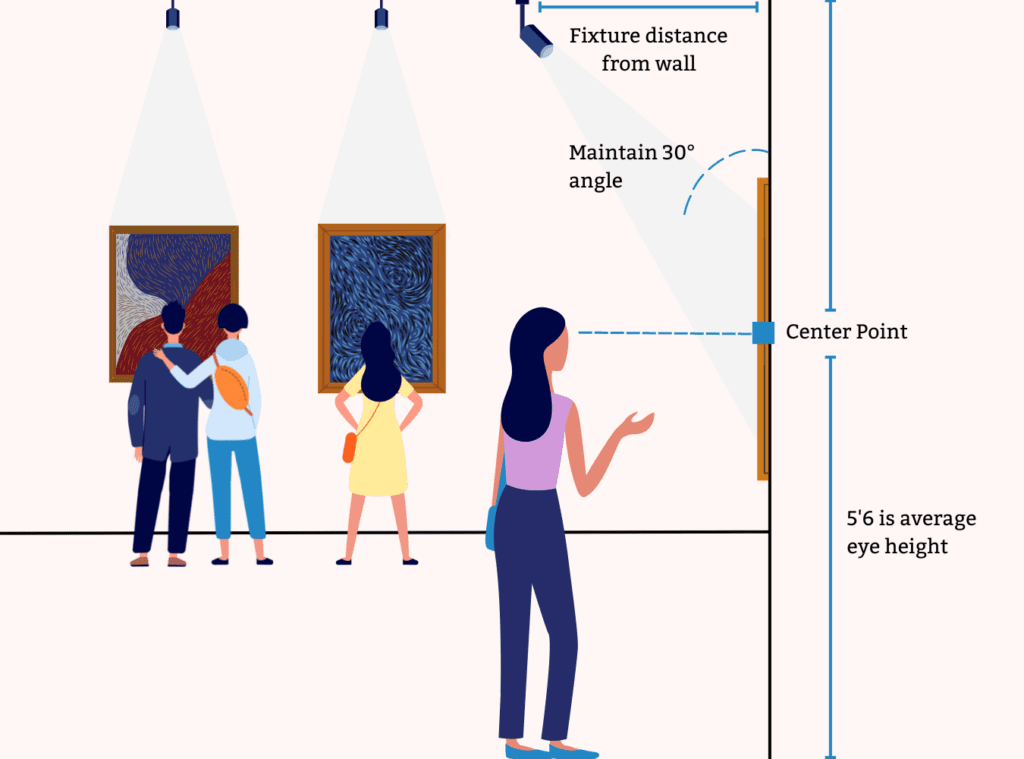
The primary advantage of track lighting is the capacity to aim spotlights where needed. Track lights also offer the benefit of retaining their proper color temperature even when dimmed.
However, this type of lighting is often seen as cost-prohibitive for smaller galleries with budget concerns. The good news is that the cost of LED track lighting is becoming comparable to its halogen counterparts. So, it may be worth pricing out LED options for your client and including lifetime maintenance costs as part of the conversation.
In addition to professional track lighting, trimless adjustable recessed lighting is another option. Adjustable recessed lighting provides a cleaner, more high-end look, and is often preferable in low-ceiling applications.
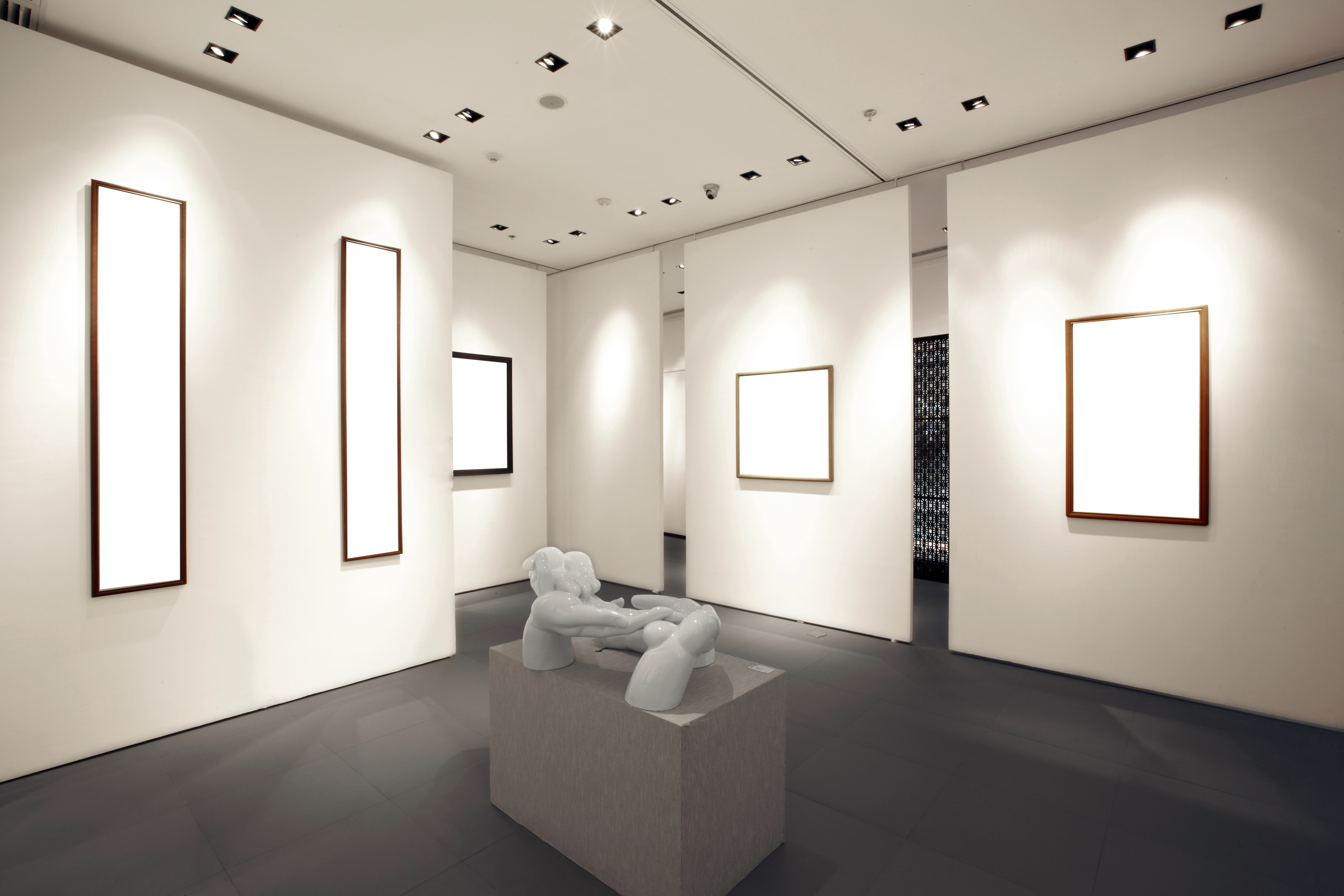
Types of light sources to use in an art gallery
Gallery lighting requires a careful selection of light sources to ensure that artworks are displayed effectively while considering factors like color render, heat emission and UV radiation. The most common light sources used in gallery lighting are:
1. Filtered natural/sunlight
Utilizing natural light in art galleries can enhance the visual experience for visitors and create a dynamic atmosphere. Here are some tips to make the most of natural light.
- Strategic window placement
- When designing your gallery, strategically place windows to allow even natural light distribution. Avoid direct sunlight on artwork to prevent damage.
- Be mindful of the changing angle and intensity of the sun throughout the seasons. Adjustments may be needed to account for variations in natural light conditions, especially during periods of more direct sunlight.
- If feasible, consider integrating skylights into the gallery roof. Skylights can provide a controlled and consistent source of natural light, minimizing the impact of direct sunlight and allowing for even illumination.
- Diffuse natural light
- Use diffusing materials on windows to soften and disperse natural light, minimizing harsh shadows. This helps prevent harsh shadows and minimizes the risk of overexposure to specific artworks.
- Diffusers can be in the form of sheer curtains, blinds or frosted glass. Adjustable blinds or shades can be used to regulate the amount of natural light entering the space. This provides flexibility in adapting to changing lighting conditions throughout the day.
- Artwork placement and reflective surfaces
- Arrange artworks with consideration for the direction and intensity of natural light. Place more robust or light-resistant pieces, such as sculptures, closer to windows, while sensitive or light-prone artworks, such as wet plate photographs, can be displayed away from direct sunlight.
- Incorporate reflective surfaces like light-colored walls or mirrors to bounce natural light deeper into the space.
- The downsides
- UV radiation: Install UV-filtering films on windows and, when possible, frames to reduce the amount of ultraviolet (UV) radiation entering the gallery. UV protection helps preserve artwork and prevents color fading over time.
- Inconsistent lighting conditions: Natural light is subject to variations throughout the day and is influenced by weather conditions. This results in inconsistent conditions, impacting the perceived colors and details of artworks.
- Glare and reflections: Sunlight can create glare on framed artworks, glass surfaces and glossy paintings. This can impede visibility and make it challenging for viewers to appreciate the work without distractions unless properly diffused.
- Heat emission: Sunlight contributes to heat buildup in gallery spaces, potentially posing a risk to delicate artworks. Heat management strategies, such as shading devices or air conditioning, may be necessary to mitigate this issue.
- Limited control: Galleries have limited control over natural light, making it challenging to create a consistent and controlled lighting environment. This lack of control may impact the gallery’s ability to showcase artworks optimally without assistance from other light sources.
2. LED
LED lighting is becoming increasingly popular in gallery lighting. They come in a range of color temperatures, providing flexibility for different art styles as well as being energy-efficient. LEDs also emit very little heat and can be dimmed, making them suitable for delicate artworks.
- Adjustable color temperature and dimming controls
- Opt for LED fixtures with adjustable color temperature. This feature allows you to fine-tune the lighting to suit different art styles and create the desired ambiance in the gallery space.
- Install dimming controls to adjust the light levels according to the specific requirements of different artworks or events. Dimming also contributes to energy savings and can create different moods within the gallery.
- UV control for art preservation
- Choose LED lights with UV filters or coatings to minimize UV radiation. This helps protect sensitive artworks from potential damage, contributing to the preservation of the art.
- General illumination
- LED Lights are energy-efficient and can be used for general illumination throughout the gallery space. Install them in track lighting or recessed fixtures to provide consistent and uniform lighting. They can be used for directional lighting, similar to halogens. Their flexibility in beam control makes them suitable for accentuating specific artworks or creating focal points.
- Select high-quality LED fixtures
- Choose LED fixtures from reputable manufacturers with high color rendering index (CRI) values. A high CRI ensures accurate color representation, crucial for showcasing artworks as intended by the artists. Search for LED fixtures that meet the color rendering requirements provided by TM-30 as it ensures a more accurate rendering quality than previous testing methods.
- The downsides
- Color temperature consistency: Some LED products may have variations in color temperature, especially if they come from different manufacturers or batches. Maintaining consistent color temperature is crucial in gallery lighting to ensure accurate color representation of artworks.
- Dimming compatibility: Not all LED fixtures are compatible with standard dimmer switches. If dimming capabilities are essential for creating different lighting atmospheres, it’s important to choose LED products specifically designed for dimming.
- Blue light and UV emission: Some LED lights emit a higher proportion of blue light, which can contribute to eye strain or discomfort for viewers. Selecting LED lights with lower blue light content or implementing proper color temperature adjustments can mitigate the issue. While modern LED lights are designed with low UV emission, some products may still emit small amounts of UV radiation. Be sure to select LEDs with UV filters to minimize any impact on sensitive artworks.
- Potential flicker: Inexpensive or poorly designed LED fixtures may exhibit flickering, which can be distracting and uncomfortable for viewers. High-quality LED products designed to minimize flicker should be used.
3. Halogen
Halogen bulbs offer excellent color rendering, showcasing artwork with vibrant and accurate colors. However, they emit more heat than LEDs and have a shorter lifespan. Proper ventilation and heat management are essential when using halogen lights.
- Accent lighting
- Use halogen lights for accent lighting to highlight individual artworks or specific areas within the gallery. The directional and focused beam of halogen bulbs is well suited for drawing attention to details and creating visual interest.
- Color rendering
- Leverage the excellent color rendering capabilities of halogen bulbs. Halogen lights reproduce colors accurately, showcasing artworks with vibrant and true-to-light color representation.
- Exploit the warm color temperature of halogen lights to create a cozy and inviting atmosphere in certain areas of the gallery. This can contribute to the overall ambiance and enhance the visitor experience.
- The downsides
- Heat emission: One Significant downside of halogen lights is their high heat emission. Halogen bulbs can become very hot, posing a risk to delicate artworks, especially those made of sensitive materials. Proper ventilation and heat management are essential to prevent damage.
- Energy inefficiency: Halogen lights are less energy-efficient compared to newer technologies such as LEDs. They produce more heat than light, leading to increased energy consumption.
- Limited flexibility in color temperature and UV emission: While halogen lights provide warm color temperatures, they have limited flexibility in adjusting color temperature compared to some LED fixtures. This may be a consideration when trying to achieve specific lighting effects or adapt to different art styles. Halogen lights also emit a certain amount of ultraviolet (UV) radiation, which can be detrimental to artwork over time. If used, galleries should take measurements to minimize UV exposure, such as with filters or coatings.
Integration tips
With these guidelines in mind, you can design the best lighting for a gallery, creating the right atmosphere while still allowing the art to be seen in the best light possible.
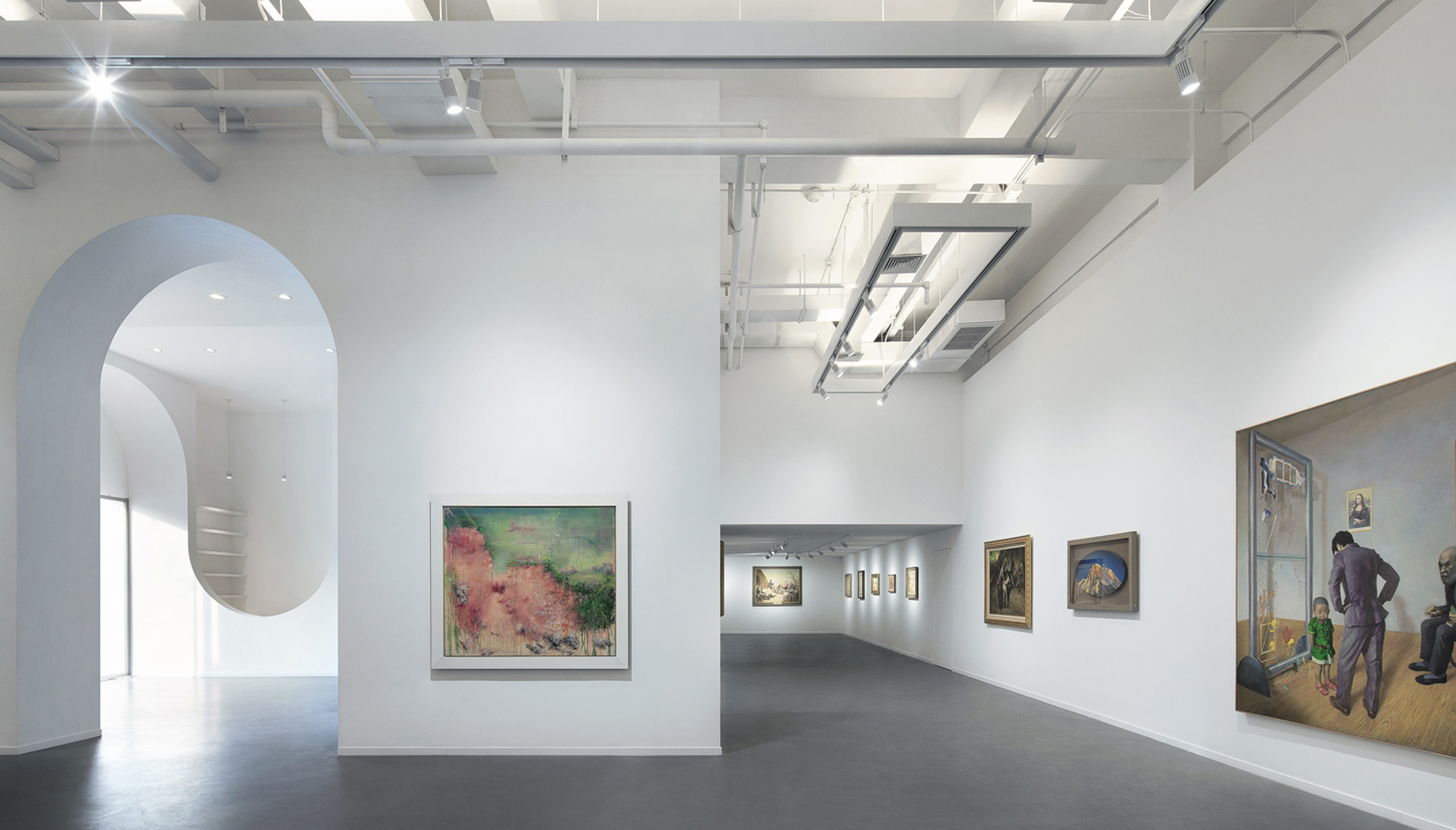
- Balance and consistency
- Aim for a balanced combination of halogen, LED and natural light sources to create a cohesive design.
- Ensure consistency in color temperature and intensity across fixtures for a unified look.
- Layered lighting
- Implement a layered lighting approach, multiple sources to create general illumination and draw focus with LED and halogen light sources. This creates depth and visual interest in the gallery space.
- Dimming controls
- Use Dimming controls for halogen and LED fixtures to adjust the lighting levels according to the specific needs of different artworks or events. Dimming control can be used to offset inconsistencies in natural lighting, set atmosphere for events, reduce eye strain, and preserve delicate artworks when not being actively viewed.
Sources:
Conserv. “Museum Lighting Design: Natural vs. Artificial Light Sources.” Conserv Blog, October 6, 2023.
“How to Light Your Artworks.” Christie’s, July 18, 2019.
“Light Exposure for Artifacts on Exhibition.” Light Exposure for Artifacts on Exhibition. Accessed January 19, 2024.
Michalski, Stefan, and Jim Druzik . “LED Lighting in Museums and Art Galleries – Technical Bulletin 36.” Canada.ca, May 5, 2020.
Park West Gallery. “3 Tips for Lighting Art.” Park West Gallery, December 18,
Recommended practice for museum lighting. New York, NY: Illuminating Engineering Society of North America, 2017.
Saunders, David. Museum Lighting: A guide for conservators and curators. Los Angeles: The Getty Conservation Institute, 2020.
Sutton Vane, Mark. Lighting guide 8: Lighting for museums and Art Galleries. London: Society of Light and Lighting, 2021.Wolfer, Lauren. “Spotlight on Lighting: How the Art Gets Lit.” From the Fort Wayne Museum of Art, July 8, 2020.
Lindsay Alayne Stevens is a multidisciplinary designer, artist and writer. She holds an MFA in Theater Design (Lighting) from UCSD ('21) and BFAs with High Honors from Marlboro College in Theater, Photography, and Writing ('17). She works as a freelance lighting designer and teaches lighting at the university level.

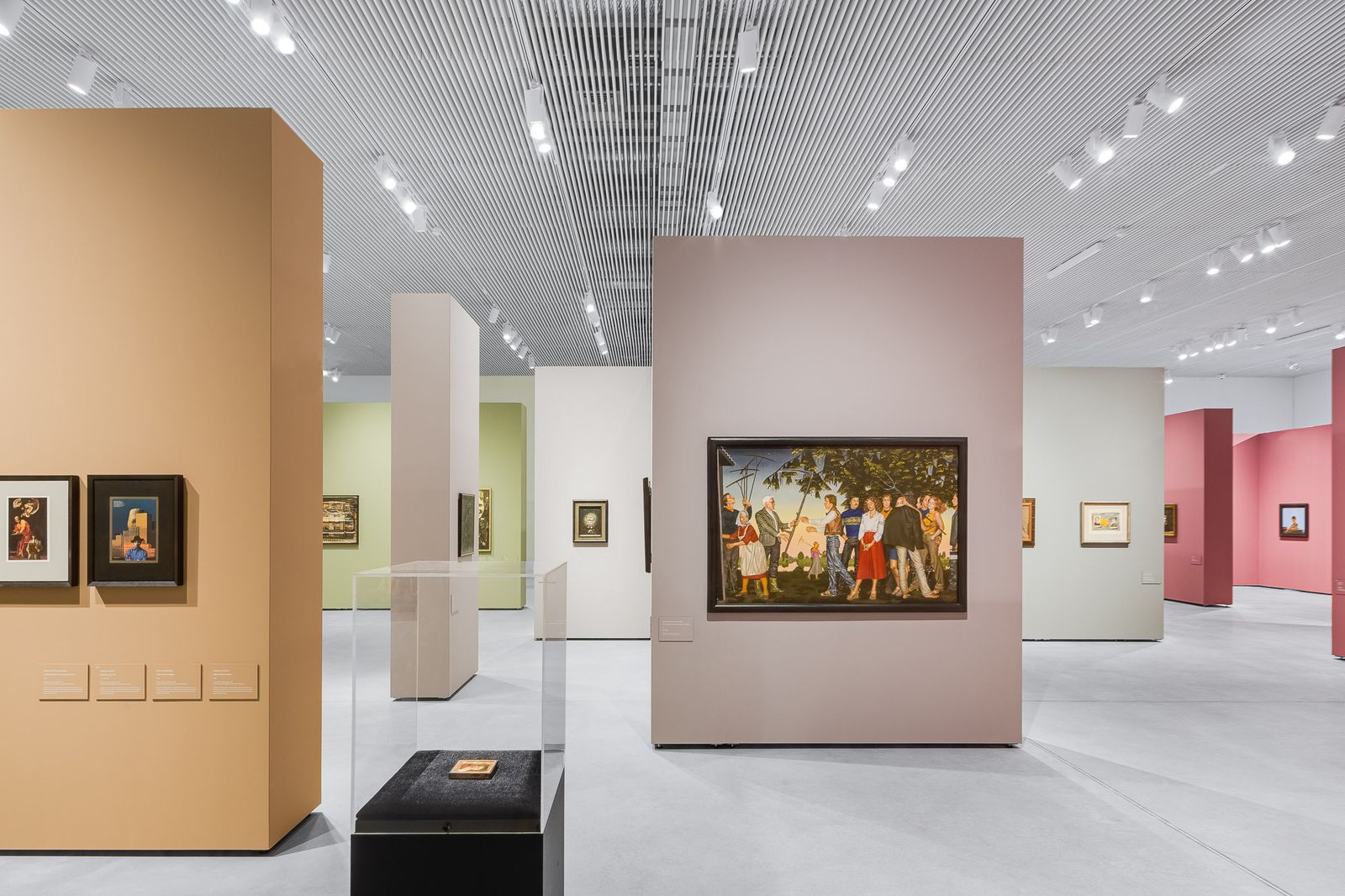

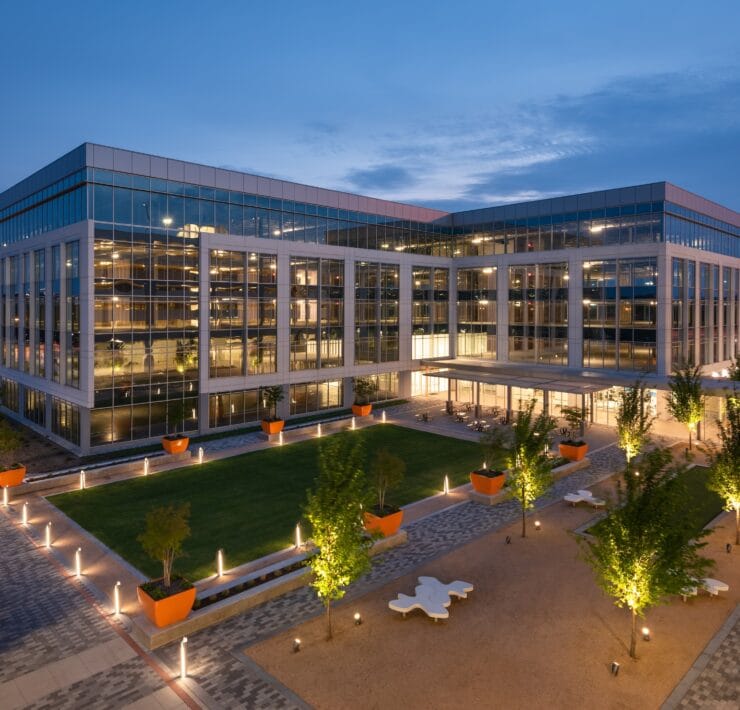
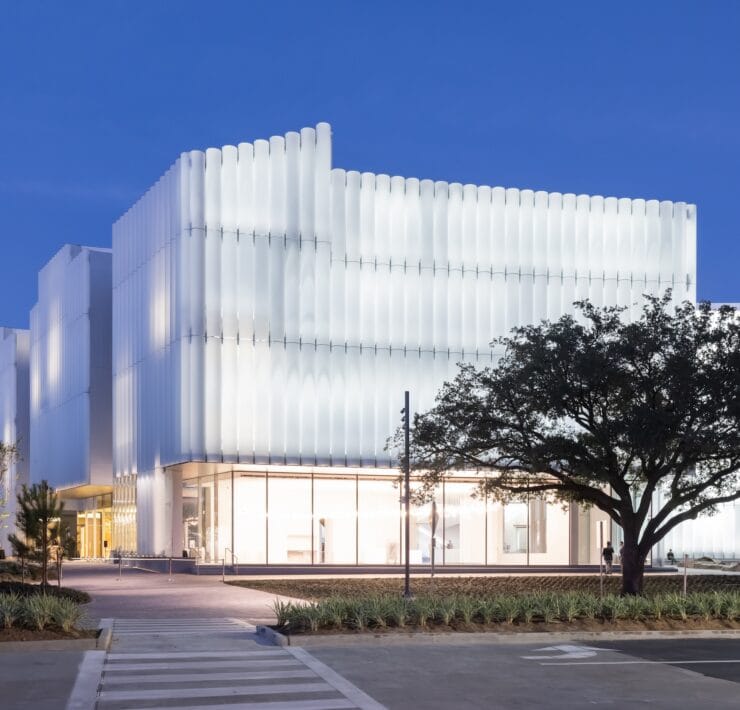
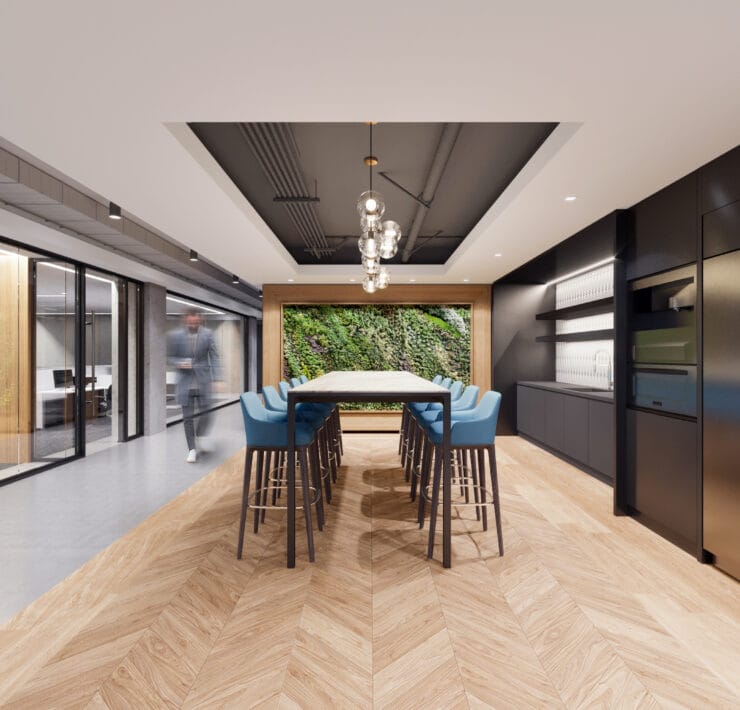
[…] Good looks combined with reliability and lower cost; read more about the benefits of track lighting for displaying art in the Art of Lighting Art. […]
[…] a lot to think about when it comes to the art of lighting art. On the technical design side, there are two main factors to consider: light color temperature, or […]
Can you recommend lighting manufacturers for residential
Yes, Teresa. I will message you a couple options.
Have a log building with sheet rock walls – need ideas of lighting art work on the walls for a gallery Friday night art shows !! With Very Tall ceiling and Log beams throughout the space.
Hello ! I am an educator at a k-12 private school. We have an art gallery and show local artists’ work as well as that of our students. We have old halogen spots with Par 36 screw base bulbs. We can’t change the fixtures, but want to find LED bulbs that will… Read more »
Hi Elizabeth,
What are the specs of the Halogen PAR36 you are wanting to replace? The lumen output of the test LED bulb you purchased may be considerably less than the halogen par lamp you’re replacing.
Regards,
David
There are two *highly* misleading assertions in this, specifically regarding color rendering. Multiple times throughout the piece, the author misleadingly asserts that LED lighting “provides superior color rendering index (CRI) compared to other light sources.” This is incorrect and misleading as a blanket assertion without qualification: 1) Incandescent and halogen… Read more »
Cristopher, I appreciate your detailed insights into the complexities of Color Rendering Index (CRI) and the nuances of different lighting technologies. You rightly pointed out that the statement regarding LED lighting’s superiority in CRI needs more qualification and context. Your emphasis on the importance of educating consumers accurately about lighting… Read more »